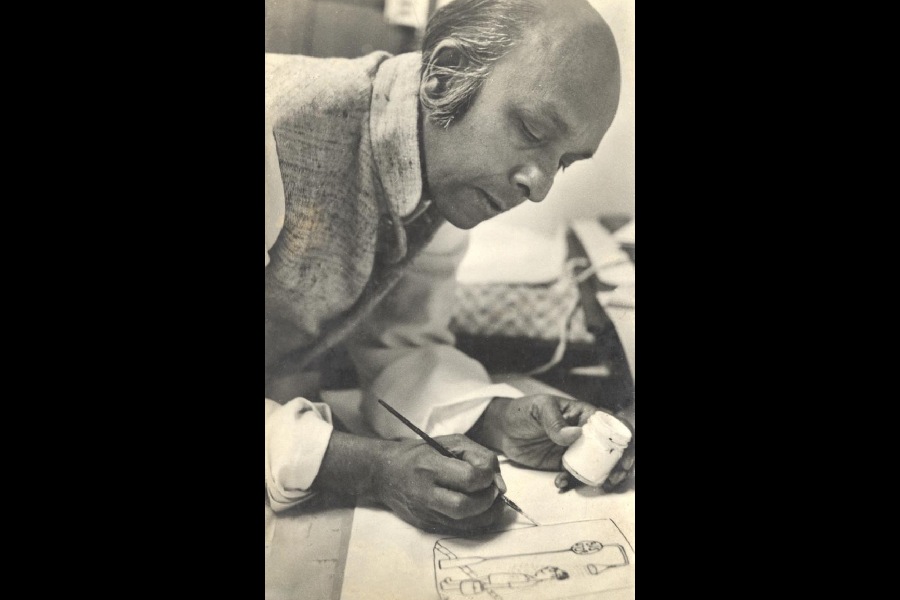Be it the rise of Hindutva, Palestine bloodbath, godi media, duplicitous politicians or other burning issues of Indian and world politics that he bristled at, it is uncanny how the cartoons of Attupurathu Mathew Abraham (1924-2002) still have not lost their bite or contemporaneity.
Gallery Rasa celebrates the centenary of abrasive Abu, nom de plume of the political cartoonist and journalist, who worked for various national and international newspapers in a career spanning 40 years — through a show of 100 of his cartoons titled The World Through Abu’s Eyes; A Centennial Exhibition.
In the 1950s, up to the late 1960s in London, he sold cartoons to Punch, the quintessentially British magazine of humour and satire, and the Daily Sketch and contributed to The Observer, the political magazine, Tribune, and The Guardian. He was appointed the first political cartoonist of the British Sunday newspaper The Observer.
In India, he had a long stint with The Indian Express, and in the 1990s, he wrote a column for The Telegraph. It was during his Indian Express days that he introduced Private View where he spoke his mind through the tall and short politician.
Abu was born at Mavelikara in Kerala, and as his daughter, Ayisha Abraham, who was present at the opening of the exhibition on June 29, said: “He started drawing from age three and later his parents were worried that he was not pursuing a profession.”
He studied French, English and mathematics at Travancore University, Kerala, and graduated in 1945. He began his career as a journalist as a reporter for Bombay Chronicle (he was a crime reporter) and its afternoon sister paper Bombay Sentinel, and in his spare time, he drew cartoons for publications like the tabloid, Blitz, and the political journal, Bharat.
In 1951, cartoonist K. Shankar Pillai invited him to join his humour and satire magazine Shankar’s Weekly, where leading south Indian cartoonists had begun their careers.
Abu moved to the UK in 1953, where he honed his skills as a cartoonist. He was a founder member of the British Cartoonists’ Association in 1966. He travelled extensively and some of the excellent drawings he did of local people are presented.
In Israel, Abu made sketches of the trial of the Nazi war criminal Adolf Eichmann. One of his cartoons showed Gandhi being led by a Palestinian boy through the ruins of his motherland in an image reminiscent of the famous photograph of the Dandi Salt Satyagraha in 1930.
Echoing this image, in another cartoon, Gandhi takes a puny politician by surprise by poking him with his walking stick. In Cuba, he spent three hours in a night club with Fidel Castro. During the Emergency, when dissent became a dirty word, political opponents were put behind bars and the media were muzzled, his barbed humour targeted Indira Gandhi and her cohorts.
He freelanced after leaving The Indian Express in 1981. In 1968, he scripted a political allegory titled “No Arks”, based on the Noah’s Ark story. It won a Special Award from the British Film Institute the next year. It is being screened at the exhibition.
Among his books were the collection of his cartoons titled Verdicts on Vietnam, Abu on Bangladesh, The Games of Emergency and Arrivals and Departure: Abu on Janata Rule. He edited the Penguin Book of Indian Cartoons. In 1988 he returned to Thiruvananthapuram in Kerala where he died. The timeline gave viewers a clear picture of Abu’s life and work.
How has such a huge collection of cartoons, drawings and other memorabilia survived? Ayisha Abraham says her father kept everything meticulously, and when he was on The Indian Express, he made sure the daily cartoons were returned.
He kept his scrapbook carefully but some of the archive got destroyed by white ants. The bulk of his cartoons are from 1950 to 1981, when he was in Delhi. “All his figures of Indians were observed from life. He never drew from photographs,” says his daughter.
Gallerist Rakesh Sahni says he wanted to show cartoons because they hark back to a time “when dissent was accepted”.
The artwork pool was painstakingly put together by Abu’s daughters, Ayisha and Janaki Abraham, for the year-long centenary celebrations. Some Bengal-centric pieces were added to it by Rakesh Sahni and Siddharth Siva Kumar, creative director of Gallery Rasa, from their Bangalore visit before the show.
From the 253 works that came for the show, 165 were finally selected, categorised, displayed and annotated by Siddharth. Weekend outreach programmes have added to the attraction of the exhibition.
The exhibition is on till July 21.










